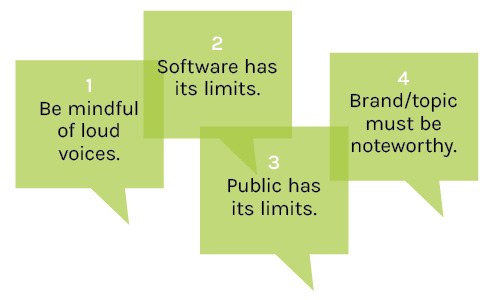Do you hear that? There’s a buzz in the air! What’s that you’re saying? Tell me more!
Social Listening is a tool that can be used in tandem with other tried and true approaches to help you figure out what conversations are taking place about your brand. It takes social monitoring to the next level, and is defined as the process of tracking conversations around specific topics, keywords, phrases, brands or industries, and leveraging those insights to discover opportunities or create content for those audiences.
Because of the analytic aspects of Social Listening, it is an actionable component of a marketing research program that allows you to stay “in-the-know” when it comes to buzz about your brand and/or industry.
It certainly provides a unique perspective that would be hard to achieve any other way by allowing you to hear from real people who are actively engaging in conversations about a specific brand, industry, or topic. And the resulting analysis can offer insights as to what you can do to engage, entice and delight them.
Social listening provides a unique perspective that would be hard to achieve any other way by allowing you to hear from real people … And the resulting analysis can offer insights as to what you can do to engage, entice and delight them.”
Getting an aerial view of the conversations that are already taking place also provides an opportunity to identify topics consumers want to hear more about and a forum to generate such conversations.
Despite the compelling aspects of social listening we must be wary of its limitations. Yes, it can provide opportunities to take proactive steps with consumers such as: Answering a product related question, refuting an incorrect claim, or providing product recommendations. Social listening can also offer insights related to expectations and perceived brand delivery.
But what should you watch out for?

1. Be mindful of loud voices. There are uber-active posters who have a tendency to dominate the social conversation, potentially painting an incomplete picture of the actual conversations that are taking place. It is incumbent on us to make sure we pay attention to a variety of sources and contributors.
2. Software has its limits. Realize we depend on software to gather, sort, and interpret social media data. We need to be aware and mindful of the potential for this software to misinterpret sentimental context, such as in the case of sarcasm.
3. Public has its limits. Social media is limited to public content, and not all social media is public. For example, platforms like Snapchat are invitation only, where posts are only shared with invited guests. Even on Facebook and Instagram, users can limit who can see their posts. Once audiences are limited, Social Listening cannot capture them.
4. Brand/topic must be noteworthy. In other words, social listening is only valuable for brands, products, services and industries about which people tend to chatter — there has to be meaningful content out there to make listening to it worthwhile.
Ready to take a good listen as part of your research program?





